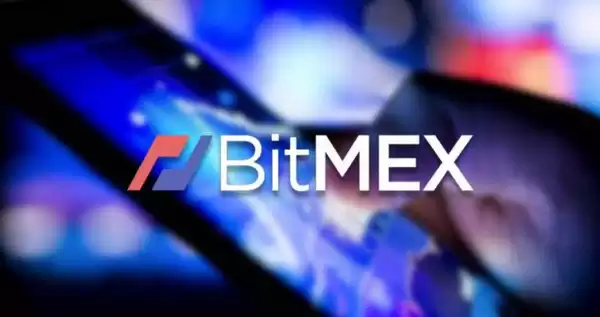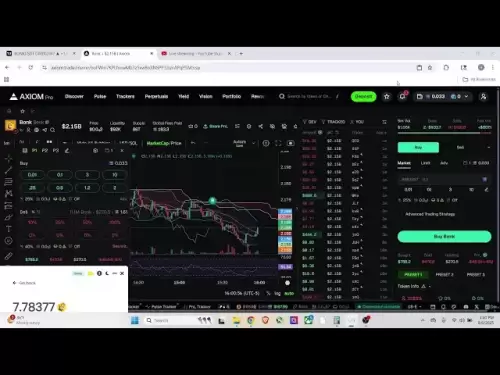-
 Bitcoin
Bitcoin $116700
2.16% -
 Ethereum
Ethereum $3830
5.76% -
 XRP
XRP $3.082
4.56% -
 Tether USDt
Tether USDt $1.000
0.04% -
 BNB
BNB $777.8
1.96% -
 Solana
Solana $173.2
5.46% -
 USDC
USDC $0.0000
0.02% -
 Dogecoin
Dogecoin $0.2146
6.85% -
 TRON
TRON $0.3384
0.92% -
 Cardano
Cardano $0.7676
5.51% -
 Hyperliquid
Hyperliquid $39.28
4.90% -
 Sui
Sui $3.723
9.07% -
 Stellar
Stellar $0.4164
6.32% -
 Chainlink
Chainlink $17.36
5.78% -
 Bitcoin Cash
Bitcoin Cash $580.9
3.62% -
 Hedera
Hedera $0.2544
5.50% -
 Ethena USDe
Ethena USDe $1.001
0.02% -
 Avalanche
Avalanche $22.81
3.81% -
 Litecoin
Litecoin $120.8
3.60% -
 UNUS SED LEO
UNUS SED LEO $8.956
-0.35% -
 Toncoin
Toncoin $3.311
4.28% -
 Shiba Inu
Shiba Inu $0.00001266
4.15% -
 Uniswap
Uniswap $10.10
5.97% -
 Polkadot
Polkadot $3.786
4.80% -
 Dai
Dai $1.000
0.01% -
 Monero
Monero $280.4
-4.02% -
 Bitget Token
Bitget Token $4.405
1.69% -
 Cronos
Cronos $0.1480
5.13% -
 Pepe
Pepe $0.00001087
5.67% -
 Ethena
Ethena $0.6348
11.62%
BitMEX leverage trading rules
BitMEX's leverage trading rules, including maximum leverage limits, margin requirements, and liquidation procedures, aim to protect traders and maintain market stability.
Nov 11, 2024 at 06:24 am

BitMEX Leverage Trading Rules: A Comprehensive Guide
BitMEX, a leading cryptocurrency derivatives exchange, offers leverage trading, allowing users to amplify their trading positions and potentially increase their profits. However, leverage trading also carries inherent risks and requires a thorough understanding of its rules and mechanisms.
What is Leverage Trading?
Leverage trading is a technique that allows traders to utilize borrowed funds, known as leverage, to enter larger positions than they would ordinarily be able to with their available capital. The specific amount of leverage available to traders varies depending on the platform and the assets being traded.
Leverage Trading Rules on BitMEX
BitMEX offers a comprehensive set of leverage trading rules that aim to protect both the exchange and its users. These rules cover various aspects of leverage trading, including the following:
1. Maximum Leverage Limits
- BitMEX imposes maximum leverage limits that vary based on the traded cryptocurrencies and the instruments used.
- For perpetual contracts, the leverage limit is typically 100x, while for futures contracts, the limit is usually lower.
- Traders are not permitted to exceed these predetermined leverage limits.
2. Margin Requirements
- Margin refers to the minimum amount of capital that a trader must hold in their account to maintain open positions with leverage.
- BitMEX sets specific margin requirements for each traded instrument.
- Maintaining sufficient margin is crucial to avoid liquidation, which occurs when the trader's account balance falls below a certain threshold.
3. Liquidation Rules
- If a trader's account balance falls below the required margin, the exchange will initiate a liquidation process.
- During liquidation, the trader's open positions will be forcibly closed at market prices, potentially resulting in substantial losses.
- BitMEX employs a "fair price" mechanism that determines the execution price for liquidations, aiming to minimize market manipulation.
4. Position Limits
- BitMEX also enforces position limits to prevent market manipulation and excessive concentration of orders.
- Position limits vary depending on the traded cryptocurrencies and the instruments used.
- Exceeding position limits may result in the exchange canceling or adjusting the trader's orders.
5. Risk Management Tools
- BitMEX offers several risk management tools to help traders manage their exposure to leverage trading risks.
- These tools include stop-loss orders, auto-deleveraging, and the ability to manually reduce leverage levels.
- Utilizing these tools effectively can mitigate potential losses and enhance trading performance.
6. Margin Trading Availability
- BitMEX may occasionally restrict or suspend margin trading during periods of high market volatility or other extraordinary events.
- Such restrictions are implemented to safeguard the stability and integrity of the platform.
7. Risk Disclosure
- BitMEX explicitly emphasizes the inherent risks associated with leverage trading and encourages traders to fully understand the risks before engaging in this type of trading.
- The exchange clearly outlines the potential for significant losses and recommends that only experienced and knowledgeable traders utilize leverage trading.
Conclusion
Leverage trading on BitMEX is subject to a comprehensive set of rules designed to protect both the exchange and its users. These rules govern aspects such as maximum leverage limits, margin requirements, liquidation procedures, position limits, risk management tools, margin trading availability, and risk disclosure. Understanding and adhering to these rules is essential for successful and responsible leverage trading on BitMEX.
Disclaimer:info@kdj.com
The information provided is not trading advice. kdj.com does not assume any responsibility for any investments made based on the information provided in this article. Cryptocurrencies are highly volatile and it is highly recommended that you invest with caution after thorough research!
If you believe that the content used on this website infringes your copyright, please contact us immediately (info@kdj.com) and we will delete it promptly.
- BlockchainFX, Bitcoin Swift, Crypto Presales: What's the Hype?
- 2025-08-07 19:10:13
- SHIB Community at Crossroads: Shytoshi Kusama's Leadership Under Scrutiny as Elections Loom
- 2025-08-07 18:30:13
- IREN Overtakes: A New King in the Bitcoin Miner Hashrate Race?
- 2025-08-07 16:31:29
- Memecoins Mania: Whales Eye Pepe Dollar (PEPD) as Bonk Cools Off, While MoonBull Hogs the Spotlight!
- 2025-08-07 16:51:17
- Unilabs, PEPE, and Investment Risk: Navigating the Crypto Hype
- 2025-08-07 16:31:29
- Meme Coin Mania: Rug Pulls, CZ-Inspired Tokens, and the Wild West of Crypto
- 2025-08-07 16:57:14
Related knowledge

What programming languages are used for smart contracts?
Aug 07,2025 at 06:07pm
Understanding Smart Contracts and Their Execution EnvironmentSmart contracts are self-executing programs deployed on blockchain networks that automati...

What is a long position in crypto contracts?
Aug 07,2025 at 06:29pm
Understanding the Concept of a Long Position in Crypto ContractsA long position in crypto contracts refers to a trading strategy where a trader buys a...

Why is my Bitstamp futures position being liquidated?
Jul 23,2025 at 11:08am
Understanding Futures Liquidation on BitstampFutures trading on Bitstamp involves borrowing funds to open leveraged positions, which amplifies both po...

How to report Bitstamp futures for taxes?
Jul 30,2025 at 08:35am
Understanding Bitstamp Futures and Taxable EventsWhen trading Bitstamp futures, it’s essential to recognize that these financial instruments are treat...

Does Bitstamp offer inverse contracts?
Jul 23,2025 at 01:28pm
Understanding Inverse Contracts in Cryptocurrency TradingIn the realm of cryptocurrency derivatives, inverse contracts are a specific type of futures ...

What is the difference between futures and perpetuals on Bitstamp?
Jul 27,2025 at 05:08am
Understanding Futures Contracts on BitstampFutures contracts on Bitstamp are financial derivatives that allow traders to speculate on the future price...

What programming languages are used for smart contracts?
Aug 07,2025 at 06:07pm
Understanding Smart Contracts and Their Execution EnvironmentSmart contracts are self-executing programs deployed on blockchain networks that automati...

What is a long position in crypto contracts?
Aug 07,2025 at 06:29pm
Understanding the Concept of a Long Position in Crypto ContractsA long position in crypto contracts refers to a trading strategy where a trader buys a...

Why is my Bitstamp futures position being liquidated?
Jul 23,2025 at 11:08am
Understanding Futures Liquidation on BitstampFutures trading on Bitstamp involves borrowing funds to open leveraged positions, which amplifies both po...

How to report Bitstamp futures for taxes?
Jul 30,2025 at 08:35am
Understanding Bitstamp Futures and Taxable EventsWhen trading Bitstamp futures, it’s essential to recognize that these financial instruments are treat...

Does Bitstamp offer inverse contracts?
Jul 23,2025 at 01:28pm
Understanding Inverse Contracts in Cryptocurrency TradingIn the realm of cryptocurrency derivatives, inverse contracts are a specific type of futures ...

What is the difference between futures and perpetuals on Bitstamp?
Jul 27,2025 at 05:08am
Understanding Futures Contracts on BitstampFutures contracts on Bitstamp are financial derivatives that allow traders to speculate on the future price...
See all articles

























































































